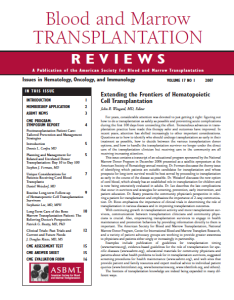 Extending the Frontiers of Hematopoietic Cell Transplantation
Extending the Frontiers of Hematopoietic Cell Transplantation
by John R. Wingard, Editor
For years, considerable attention was devoted to just getting it right: figuring out how to do a transplantation as safely as possible and preventing acute complications during the first 100 days from unraveling the effort. Tremendous advances in transplantation practice have made this therapy safer and outcomes have improved. In recent years, attention has shifted increasingly to other important considerations. Questions as to how to identify who should undergo transplantation as early in their treatment as possible, how to decide between the various transplantation donor options, and how to handle the transplantation survivor no longer under the direct care of the transplantation clinician but receiving care in the community are all receiving increasing attention.
This issue contains a transcript of an educational program sponsored by the National Marrow Donor Program in December 2006 presented as a satellite symposium at the American Society of Hematology annual meeting. Dr. Forman discusses the thorny issue of identifying which patients are suitable candidates for transplantation and whose prospects for long-term survival would be best served by proceeding to transplantation as early in the course of the disease as possible. Dr. Weisdorf discusses the new option of cord blood, which already has an established role in transplantation for children and is now being extensively evaluated in adults. Dr. Lee describes the late complications that occur in survivors and strategies for screening, prevention, early intervention, and patient education. Dr. Beatty presents the community physician’s perspective in referring a patient for transplantation and emphasizes the importance of 2-way communication. Dr. Rizzo emphasizes the importance of clinical trials in determining the role of transplantation in various diseases and in improving transplantation outcomes.
With continuing growth in transplantation activity and more transplantation survivors, communication between transplantation clinicians and community physicians is crucial. Also, empowering transplantation survivors to engage in health maintenance and promotion behaviors by providing information directly to them is important. The American Society for Blood and Marrow Transplantation, National Marrow Donor Program, Center for International Blood and Marrow Transplant Research, and a variety of patient advocacy groups are working to provide greater awareness to physicians and patients either singly or increasingly in partnership.
Examples include publication of guidelines for transplantation timing (www.marrow.org), evidence-based guidelines for the role of transplantation for specific diseases (www.asbmt.org), educational materials for community physicians and patients about what health problems to look for in transplantation survivors, suggested screening procedures for health maintenance (www.asbmt.org), and web sites that provide patient and family resources and expert medical advice to individual patient queries (www.bmtinfonet.org, www.bonemarrow.org, www.nbmtlink.org, and others). The frontiers of transplantation knowledge are indeed being expanded in many different ways.
Download a PDF version of the full issue.
